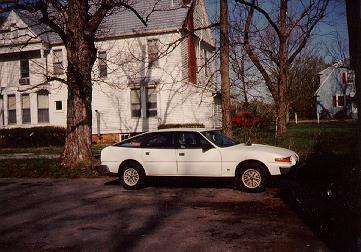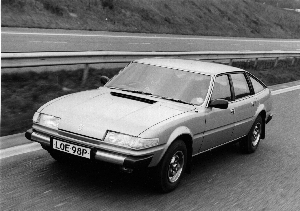SD1 1976 - 1987 - The End of an Epoch

The picture is taken by Clay Pierce in the USA. It is his own car, a SD1 V8 from 1980.
More SD1
This model was introduced in 1976 and the last car of the model was built in 1986.
When Rover released what is called the SD1 in daily speech, the inherited tradition of the company was broken in several ways. Production was not run parallell with other models to keep a variety of models as with the changes between P4, P5 and P6.
With the SD1 a certain date was decided to end the P6 no matter what happened to the new line. There was a certain feel of fatalistic "succeed or die." It was also clear for everyone involved that the new car was taken from a scenario where finances had been a crucial word, not only quality. I can hear the screams from certain people, because you love your SD1:s, just like I love mine.
This is to be remembered though after 20 years that the SD1 won not only "Car of the Year 1977" but also the prize of "Most Towed Car" in it's home country. This was a variety of "Best Towcar" which the SD1 won much thanks to it's rear self-adjusting shock-absorbers.
New Production Methods
With the SD1 new ideas regarding quality control were introduced unto production and this reduced the group of people known as quality-controllers in exchange for computers and machines. Techniques were used that in true Rover-spirit were new and in some cases pioneering, but basis was missing for what would happen a couple of years ahead.
One example was rust-protection that already after a couple of years after the introduction, proved to be below par. Even so, no-one can deny that the new Rover was a master work in several other aspects.
For starters the design was one of the most daring seen in a long time. Some argued that design elements were taken from Ferrari, Jensen and several others, but so what! Those manufacturers had become what they were through precisely that, a daring and different design, so why should not Rover head up when it came to slightly more common cars.
The, in certain cases, strict Conservative English people was nearly choked when the car was shown for the first time. Nothing resembling traditional Rover was found, possibly with the exception of the drive-train.
No leather, no wooden trims, no aerodynamics compared to milk-boxes, but a linesweeping body which was something between a hatchback and an ordinary four-door car. The critics of the new body disappeared fast and if you look in the rear-view mirror one can see that when the co-op car from Rover and Honda came in the late 80s, the production of five-door models was demanded from the buyer's side. Only to satisfy the old SD1 owners that didn't want a car from Rover with four doors only.
Buyers demanded luxury
Just short after the introduction the customers started to demand more luxury and more fully equipped SD1s. The cars of the first years had for all practical purposes everything, with minimal optionals. When it came to the 3500 the only optionals had been electrical window elevators and four-channel stereos, which became standard equipment in 1977 at the same time as the cheaper 2600 was introduced. In 1978 the sun-roof and leather interior appeared as optionals, and in 1980, with the introduction of the V8S, A/C also became an option.
For the 3500 body several different engine and equipment alternatives were developed. There was the 2000 with a four-cylinder engine, 2300 and 2600 with six-cylinder engines and the 2400SD Turbo with a four cylinder turbo-fed diesel engine, and of course the 3500 with the V8 that Rover had been using since 1968. In 1984 the latest series of the V8 came which incorporated injection in the model alternatives Vitesse, the sporty one, or as the Vanden Plas EFI which was top of the line, i.e. the luxury model
Ola Lundblad
New Zealand SD1

A SD1 3500 from 1976
SD1's were assembled in Nelson, New Zealand, (top of south island) by NZ Motor Corp. 2600's Man & Auto & 3500's (mainly autos) were produced, but knowingly no Vitesses.
The factory is now assemblying Honda's. Most manufacturers have already pulled out of New Zealand or are in process of doing so. And so will likely Honda too. This is due to the fact that duty is being reduced gradually, making local assembly in NZ non profitable.
© These texts are protected by laws on copyright. Reprint and other kinds of copying is forbidden.

